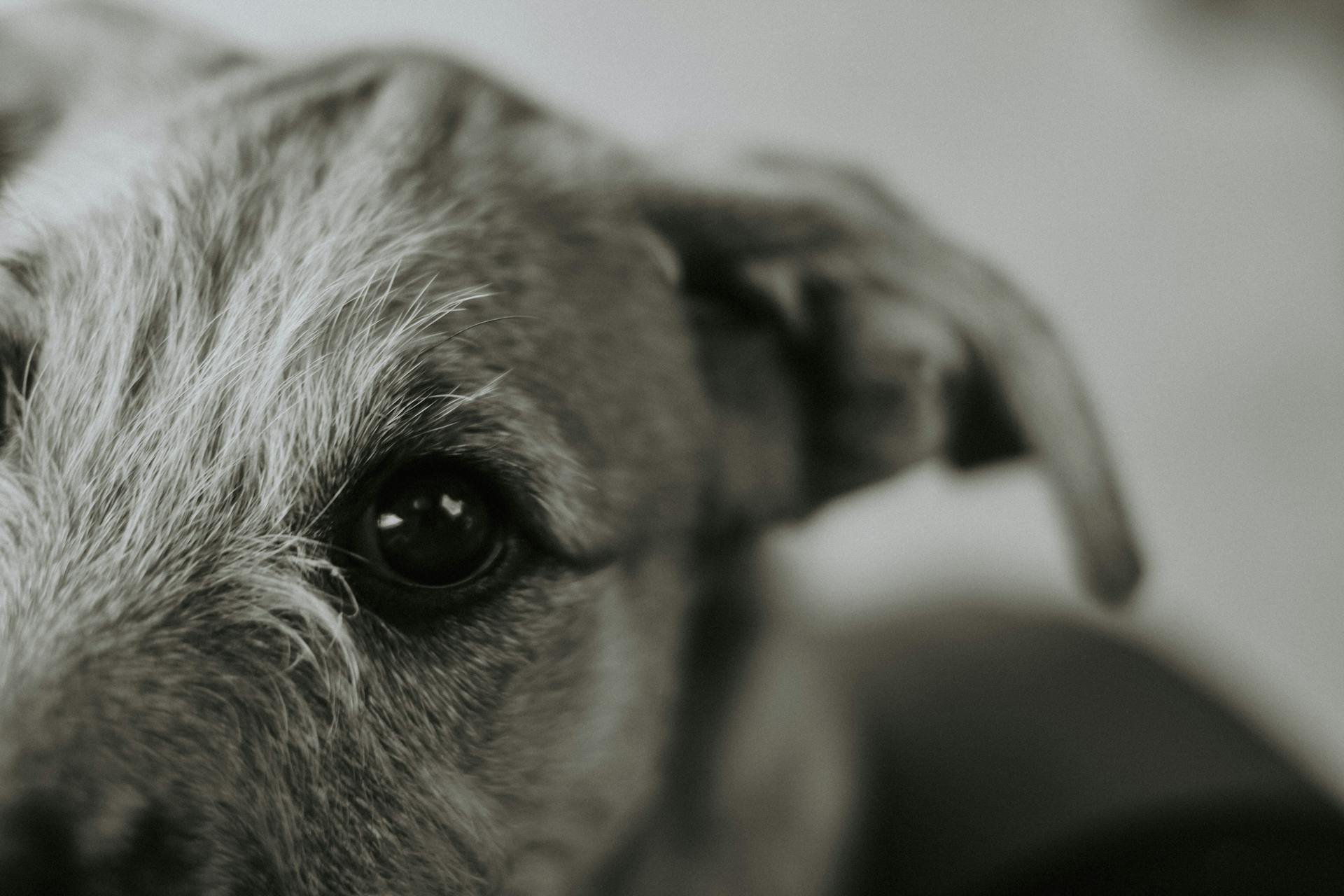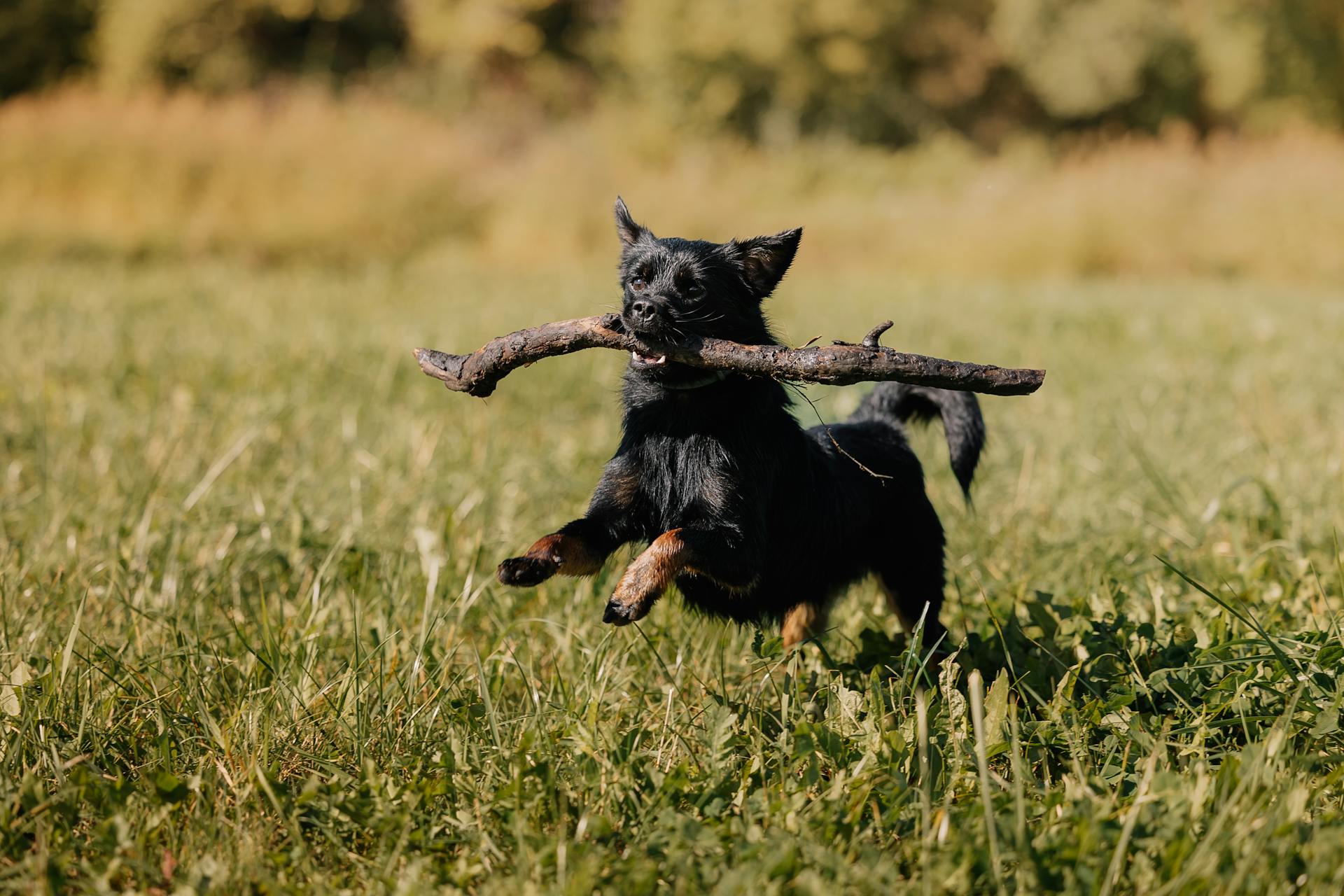
Understanding dog eye health is crucial to prevent vision loss and ensure your furry friend's overall well-being.
The eyes are one of the most sensitive organs in a dog's body, and they can be prone to various health issues, such as conjunctivitis, which is an inflammation of the conjunctiva, a thin membrane covering the white part of the eye.
A dog's eye health is closely linked to their overall health, and regular check-ups with a veterinarian can help detect potential problems early on.
Some common signs of eye problems in dogs include redness, discharge, squinting, and pawing at the eyes.
Infections and Symptoms
A dog's eye health is just as important as their overall well-being. Recognizing the early signs of eye infections is crucial for ensuring timely and effective care.
Redness in the eye is a common sign of irritation or infection. You might notice that the white part of your dog's eye appears pinker or redder than usual.
Abnormal discharge is a telltale sign of an infection. This can be clear or have a yellow or green tint.
Dogs with eye infections might squint more than usual or avoid bright areas due to discomfort or pain.
Swelling and squinting can also be indicative of an infection or other eye issues.
Changes in the appearance of the eye, such as cloudiness, film over the eye, or changes in eye color, can be symptomatic of an infection.
A decrease in appetite or less activity can accompany eye issues, suggesting the infection might be affecting your dog's overall health.
Here are the essential symptoms to watch out for:
- Redness in the eye
- Abnormal discharge
- Light sensitivity
- Swelling and squinting
- Changes in the appearance of the eye
- Behavioral changes
Maintaining Eye Health
Maintaining Eye Health is crucial for your furry friend's overall well-being and quality of life. Regular eye checks can help your veterinarian detect eye problems in the early stages.
Look into your dog's eyes regularly to see if there are any changes, like redness, cloudiness, or tearing. This simple habit can help you catch any potential issues before they become major problems.
Schedule those check-ups with your veterinarian to ensure your dog's eye health is being monitored. Routine wellness exams are a great way to stay on top of your dog's health.
Here are some tips to help keep your dog's eyes healthy and injury-free:
- Gently clean around your dog's eyes with a cotton ball or soft cloth when giving them a bath.
- Clip your dog's nails to prevent them from injuring their eye if they paw at their face.
- Trim the fur near your dog's eyes to prevent irritation.
- Close windows when driving with your dog to prevent bugs, dirt, or other debris from harming their eyes.
Maintaining Your
Maintaining Your Eye Health is crucial for your furry friend's overall well-being and quality of life. Eyes are sensitive organs that require proper care to prevent infections and other eye conditions.
Regular eye checks are essential to detect eye problems in the early stages. Schedule those check-ups with your veterinarian to ensure your dog's eye health.
Look into your dog's eyes regularly to see if there are any changes, like redness, cloudiness, or tearing. This simple habit can help you catch any issues before they become serious.
Gently clean around your dog's eyes when giving them a bath, using a cotton ball or soft cloth to wipe outward from the corner. Be careful not to scratch the eye.
Here are some things you can do to help keep your pup's eyes healthy and injury-free:
- Look into their eyes regularly
- Schedule routine wellness exams with your veterinarian
- Clean around their eyes gently
- Clip their nails to prevent eye injuries
- Trim their hair to prevent irritation
- Close windows when driving to prevent debris from entering the car
Your dedication to your dog's eye health is a testament to the love and loyalty they give you daily. By following these simple tips, you can help your dog avoid many common eye problems and infections.
Are Carrots Good for Humans?
Carrots are a crunchy, vibrant veggie that many of us enjoy munching on. They're also a great addition to a healthy diet.
Carrots are rich in vitamin A, a nutrient that's essential for maintaining eye health. This is especially important for people who spend a lot of time reading or working on computers.
Eating carrots regularly can help prevent age-related macular degeneration and cataracts. This is because vitamin A helps to protect the cornea and lens of the eye.
Carrots are also a good source of fiber and antioxidants, which can help to reduce inflammation and improve overall eye health.
Home Remedies and Prevention
If you suspect your dog has a mild eye infection, don't hesitate to seek vet approval before trying home remedies. It's always better to err on the side of caution when it comes to your furry friend's health.
For occasional and mild eye irritation, consider a warm water and salt based wash, which can help restore nutrients and natural vitamins and minerals. This can be a great way to promote a healthy digestive tract, liver, and immune system.
A sterile saline solution made with Eyebright and Goldenseal can be a great alternative to expensive vet visits. Just mix five drops of Eyebright with three drops of Goldenseal and use it to clean your dog's eye.
To prevent eye infections, focus on maintaining a healthy digestive tract, liver, and immune system through a balanced diet. This will help reduce eye discharge and ensure a clear passage for natural cleansing.
Steroids and antibiotics can actually do more harm than good in the long run, suppressing your dog's immune system and causing long-term damage.
If this caught your attention, see: Great Dane Dog Health Problems
Common Conditions
Dogs can be prone to a variety of eye conditions, with some breeds being more genetically predisposed than others.
Certain breeds, such as Bulldogs and Pugs, are more likely to develop eye problems due to their flat face structure.
Some common canine eye problems include conjunctivitis, which is an inflammation of the thin membrane covering the white part of the eye and the inside of the eyelids.
Discover more: Dog Breeds Watch Dogs
Conjunctivitis
Conjunctivitis is a common eye infection in dogs, caused by a variety of factors including foreign objects, infections, allergies, and dry eye.
Foreign objects like eyelashes or debris in the eye can trigger conjunctivitis.
Infections from bacteria or viruses are another common cause.
Allergies to environmental irritants can also lead to conjunctivitis.
Dry eye, or a lack of natural tear production, can cause the same issue.
The symptoms of conjunctivitis are pretty unmistakable: eye discharge, redness and swelling around the eye and eyelids, and itchiness and pain that can lead to pawing at the eye and squinting.
Eye discharge can be clear, cloudy, yellow, or greenish, depending on the underlying cause.
Redness and swelling around the eye and eyelids are a hallmark of conjunctivitis.
Itchiness and pain can be quite uncomfortable for dogs, causing them to paw at their eye and squint.
On a similar theme: Types of Dog Eye Infections
Cataracts

As your dog ages, you may start to notice their eyes getting cloudy or white - this is often a sign of cataracts.
Cataracts are a condition where the lens in your dog's eye becomes cloudier, eventually leading to full vision loss if left untreated.
Some breeds are more susceptible to hereditary cataracts, including the Australian Shepherd, Bichon Frise, and Labrador Retriever.
Cataracts can be caused by age, trauma, or underlying illnesses like diabetes, and can occur in both eyes.
Prompt diagnosis is key, as cataracts can lead to more serious issues like glaucoma if left untreated.
If you notice signs of cataracts in your dog's eyes, contact your veterinarian right away.
Corneal Dystrophy
Corneal dystrophy is a common condition in dogs that affects the cornea, giving it an opaque, cloudy appearance. Some breeds are more susceptible to this condition than others.
Shetland Sheepdogs are particularly prone to epithelial corneal dystrophy, which affects the superficial layers of the cornea. This condition can be uncomfortable for dogs.
Airedale Terriers, Cocker Spaniels, Cavalier King Charles Spaniels, Samoyeds, and Weimaraners are predisposed to stromal corneal dystrophy, which affects the middle layer of the cornea.
Dogs with endothelial corneal dystrophy, which affects the deepest corneal layer, are typically middle-aged or older. Boston Terriers, Chihuahuas, and Dachshunds are genetically predisposed to this condition.
Cherry
Dogs have three eyelids, but one of them is normally hidden away in the inner corner of the eyelid.
Cherry Eye is a common condition in dogs where the third eyelid sticks out like a red cherry from the corner of their eye. It's more prevalent in certain breeds, like Beagles, Bulldogs, Cocker Spaniels, Bloodhounds, and Shih Tzu.
This condition typically requires surgery to repair, which is a serious medical issue that needs prompt attention.
Dogs with Cherry Eye often exhibit symptoms like redness, swelling, and discharge in the affected eye.
Breed-Specific Risks and Care
If you're a dog owner, it's essential to know the potential health risks associated with your breed. Some breeds are more prone to developing eye conditions than others.
English Bulldogs, Cocker Spaniels, Pugs, and Collies are all breeds that can be more susceptible to eye problems.
You might enjoy: Green Eyed Dogs Breeds
Protective Gear

Protective Gear is an essential aspect of dog care, especially for breeds that are prone to eye injuries. Dog goggles can be a lifesaver for dogs that enjoy rides in convertibles, where strong wind can cause eye strain and potential injuries.
Heavy vegetation can also pose a risk to your dog's eyes, so consider investing in protective eyewear for walks in dense areas.
Understand Breed Risks
Some breeds are more prone to developing eye conditions, such as English Bulldogs, Cocker Spaniels, Pugs, and Collies.
English Bulldogs, for example, are known to be at risk for eye problems, so it's essential to keep a close eye on their health.
Regular check-ups with your vet are crucial to catch any potential issues early on, especially for breeds like Pugs that are prone to eye conditions.
Collies, on the other hand, are at risk for hip dysplasia, which can lead to arthritis and mobility issues if left untreated.
Asking your vet about your pup's specific breed risks can help you stay on top of their health and catch any potential issues before they become major problems.
Broaden your view: English Bulldog Eye Boogers
Care for
Caring for your dog's eyes is crucial, and there are some breed-specific risks to be aware of. Regular eye checks can help detect problems early on.
To keep your dog's eyes healthy, schedule routine wellness exams with your veterinarian. This can help catch eye problems before you notice them.
Look into your dog's eyes regularly to check for changes like redness, cloudiness, or tearing. This is especially important for breeds prone to eye issues.
Cleaning around your dog's eyes gently can help prevent irritation. Use a cotton ball or soft cloth to wipe outward from the corner, and be careful not to scratch the eye.
Trimming your dog's nails can help prevent eye injuries from pawing at their face. If you're unsure, ask your veterinarian or groomer for guidance.
In the car, keep windows closed to prevent bugs, dirt, or debris from flying in and harming your dog's eyes. This is especially important for breeds with long hair around their eyes.
Here are some key eye care tips to remember:
- Look into your dog's eyes regularly
- Schedule routine wellness exams
- Clean around their eyes gently
- Trim their nails
- Keep car windows closed
Mass
If you notice a bump on or at the edge of your dog's eyelid, it's best to have it checked out by your veterinarian.
These masses are often not cancerous, but it's essential to determine the cause.
Cysts and benign tumors can cause eyelid masses, and your veterinarian can help identify the issue.
Surgical removal may be necessary if the mass is cancerous or problematic, but your vet can advise on the best course of action.
Your veterinarian can also help determine if the mass is cancerous, which is a crucial step in deciding the next steps.
In many cases, these masses are benign, but it's always better to be safe than sorry and get a professional opinion.
Sources
- https://snoutsnstouts.com/dog-safety/dog-eye-infection/
- https://seaweedfordogs.com/en-us/blogs/news/eye-health-and-weeping-eyes-in-dogs
- https://www.petinsurancereview.com/blog/dog-eye-health-assessing-and-optimizing
- https://www.akc.org/expert-advice/health/cloudy-eyes-in-dogs/
- https://www.aspcapetinsurance.com/resources/top-eye-problems-for-dogs/
Featured Images: pexels.com


